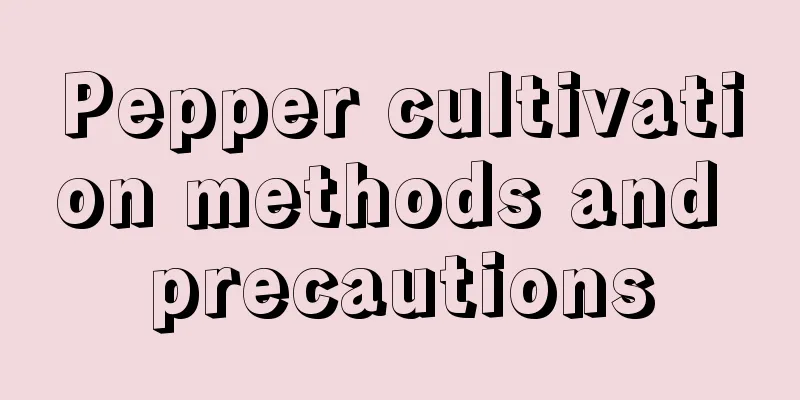Pepper cultivation methods and precautions

1. Maintenance methods1. Temperature: Different growth periods have different temperature conditions. For seeds sown in spring, the suitable temperature for development is between 15 and 30 degrees; during the growth period, the temperature should be controlled at around 20 degrees, because the growth state is best at this time. 2. Watering: It is not drought-tolerant or waterlogged. If the soil is in a dry state for a long time, the plant will die in less than three days. If the plant is in soil with stagnant water for a long time, the leaves will droop after a few hours, and in severe cases, it will die. Therefore, you must control the amount when watering it. Water it until the soil is completely moist but there is no water accumulation. Avoid watering on rainy days. The frequency of watering is once every three days. 3. Fertilization: Its growth consumes a lot of fertilizer. If the nutrition cannot keep up, the plant will appear weak. Use thin fertilizer each time you apply fertilizer, and water the plant once after fertilizing. One reason is to allow the fertilizer to melt into the soil for easy absorption by the plant; the other is to dilute the fertilizer and avoid fertilizer damage. The frequency of fertilization is once or twice a month. 4. Light: The demand for light is relatively high during the seedling stage, but there is no requirement for light. It is best to receive full-day sunlight. However, during the fruiting period, appropriate shade is needed. If the light is too strong, the fruit will easily rot. 2. Breeding techniques1. Reproduction: It can be propagated by sowing. After the climate stabilizes in spring, sow the seeds in holes, two to three seeds in each hole. After the seedlings emerge, pull out the seedlings that are not growing well. 2. Pruning: There is only one principle for pruning, which is to cut off the axillary buds growing from the leaf axils in time to avoid unnecessary consumption of nutrients. 3. Problem Diagnosis1. Pests: The plant is easily infected by borers, which will eat from the inside of the fruit, spread diseases, and affect the health of the plant. The plants need to be sprayed with carbendazim once every half a month to prevent them from being infected by pests. 2. Disease: The yellowing of the branches and leaves of the plant may be caused by lack of fertilizer. It is necessary to add nutrients to it. In addition to applying root fertilizer, you can also use foliar fertilizer. IV. Other issues1. Edible: edible. 2. Is it suitable for indoor cultivation: It can be grown indoors at home because it does not require high maintenance conditions and can be grown at home. |
<<: Almond cultivation methods and precautions
>>: Cultivation methods and precautions of nestweed
Recommend
How to care for Roca succulents? How to grow Roca succulents
When the Roca succulent is in good condition, it ...
Why doesn't the dripping Guanyin drip water?
Dripping Guanyin dripping water When cultivating ...
Flower language of Nepenthes
Origin of the name of Nepenthes The name Nepenthe...
What fertilizer should be applied to the fortune tree to make it grow fastest and most luxuriantly (what fertilizer should be applied to make the branches and leaves flourish)
What fertilizer should be applied to the fortune ...
Can orchids be grown on eucalyptus bark?
Can orchids be grown on eucalyptus bark? Orchids ...
How to care for azalea to make it more vigorous (home care and management methods for azalea)
1) Sunshade and protection from sun exposure Ever...
Can Chinese cabbage be planted all year round? How many crops can be planted in a year?
The producing areas of Chinese cabbage are mainly...
How to graft loquat trees
1. Time Grafting can be done in spring and autumn...
What to do if the maidenhair fern leaves are dry
Proper lighting The maidenhair fern itself is a p...
How to propagate lotus root and what to pay attention to
Lotus root propagation method The lotus root prop...
The efficacy and function of galangal
1. Basic Information In order to prevent some fri...
Are tulips poisonous? Tulip pictures
1. Is it toxic? Tulips are very ornamental plants...
Can rice washing water be used to water bamboo? The correct way to water rice washing water
Watering bamboo with rice water Bamboo can be wat...
Which month is the best to sow cosmos?
Cosmos is a herbaceous flower with very beautiful...
Pomegranates bear fruit a few years after planting
Introduction to growing pomegranates Pomegranate ...









